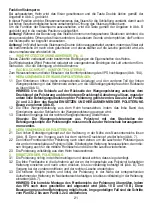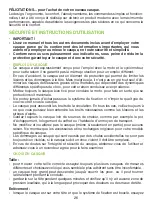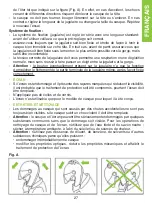
4
CHEEK PAD ASSEMBLY
4.1 Insert the band and the left chin strap into the slot of the left cheek pad.
4.2 Position and hook the flap close to the fastener in the neck-ring area (on the back) under
the shell sealing edge (see Fig. 9).
4.3 Place the left cheek pad against the polystyrene inner cheek pad and position the cheek
pad slot (the one on the back of the cheek pad) between the liner fastener and its seat,
then press until you hear the fastening click. (Fig. 6).
NOTE: In order to perform this operation, you should release the lower left snap
fastener of the liner (see step 1.1).
4.4 Now fasten the remaining 4 fasteners on the rear side of the polystyrene support to the
support itself until you hear the fastening clicks. (Fig. 5).
4.5 Repeat these steps with the padding of the right cheek pad.
WARNING!!!
-
Remove the padding only when cleaning or washing is required.
-
Never use the helmet if the inner comfort padding and the cheek pads have not been
correctly and completely reassembled.
-
Delicately hand-wash in lukewarm water (max. 30°C) and neutral soap.
-
Rinse off with cold water and dry up at room temperature away from direct sunlight.
-
Never machine-wash the inner comfort padding.
-
The inner polystyrene is an easily deformable material, in fact it is apt to change or get
partially destroyed to help absorb shocks.
-
Use a damp cloth to clean it and let it dry at room temperature away from direct sun-
light.
-
Do not modify the helmet's internal polystyrene components in any way.
-
Never use tools or equipment of any sort to carry out the steps described above.
VISION PROTECTION SYSTEM (VPS)
The new and exclusive inner Vision Protection System (VPS) is a
-moulded sun scre-
en with scratch-resistant treatment. Using it is very simple and practical: Just lower it to acti-
vate it or lift it to remove it from the field of vision. It is useful in all sorts of situations, both on
long journeys out of town and shorter town trips.
Moreover, the innovative fastening system allows you to assemble and disassemble the sun
screen without the need for any tools for ordinary maintenance and cleaning operations.
VPS OPERATION
The VPS mechanism allows activating the sun screen by simply lowering it until it partially
covers the visor field of vision. In this way, the desired light transmittance reduction is achie-
ved. At any time, without operating the visor, the VPS can be deactivated with a simple move-
ment and easily pulled up to restore the normal conditions of visibility and protection guaran-
teed by the approved helmet visor. To deactivate the VPS, push the slider downwards (Fig.
10 A) until you hear the click which means the slider and VPS are correctly in place. To acti-
vate the VPS, push the slider upwards (Fig. 10 B). The VPS has been designed to ensure an
easy, quick and tool-free disassembly.
PRECAUTIONS FOR USE
The current approval standards (ECE22-05) state that the visor minimum light transmittance
levels must be greater than 80% when riding at night and not less than 50% when riding
during the day. For this reason, when riding during the day under particularly bright weather
conditions, e.g. very strong sunlight caused by high intensity and/or incidence of the sunbe-
ams, the use of sunglasses - which entail a transmittance much lower than 50% - turns out
to be advisable, if not absolutely necessary, to reduce eye fatigue on long trips. Sunglasses
also reduce the risk of direct dazzling as opposed to the use of mere approved visors.
®
14
Содержание X-702
Страница 66: ...66...
Страница 67: ...67 E v...
Страница 73: ...2 PINLOCK 2 1 Pinlock 2 2 Pinlock 13 2 3 Pinlock 15 VPS B 16 VPS B 17 18 B 19 B 20 A A 73...
Страница 74: ...Fig 1 Fig 3 Fig 2 B1 B2 B1 B2 A1 B1 B2 A2 Fig A Fig C Fig B...
Страница 75: ...Fig 5 Fig 4 Fig 6 Fig 7 Fig 9 Fig 8...
Страница 76: ...Fig 10 A Fig 11 Fig 10 B...
Страница 77: ...Fig 12 Fig 14 Fig 13 MIN MAX...
Страница 78: ...A B Fig 15 A B Fig 16 Fig 17...
Страница 79: ...A B Fig 18 A B Fig 19 A B Fig 20...





























